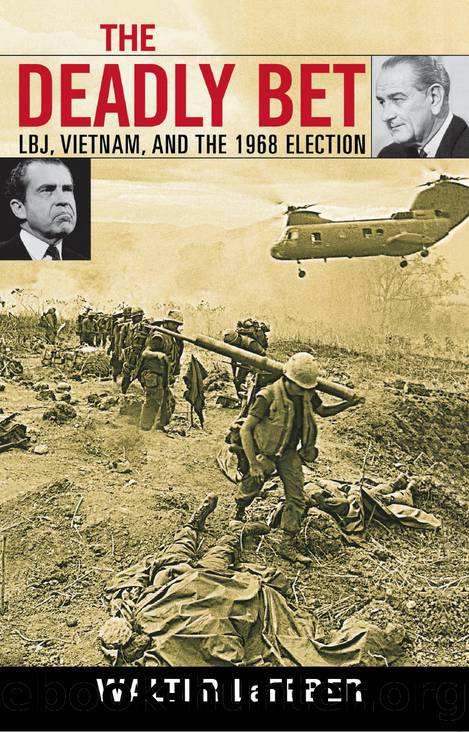The Deadly Bet by LaFeber Walter;

Author:LaFeber, Walter;
Language: eng
Format: epub
Publisher: Rowman & Littlefield Publishers
Published: 2005-08-15T00:00:00+00:00
September 6, 1968, Time Cover depicting Hubert Humphrey and Edmund Muskie with Mayor Daley in the background
Getty Images
7
HUBERT HORATIO HUMPHREY: THE ISOLATION OF THE POLITICS OF JOY
Resembling a giant surrounded by attackers intent on mutilating and then ejecting him from the scene, American liberalism entered the 1960s as the nationâs main political ideology, but at the end of the decade weakened and, in some quarters, was left for dead. The American liberal tradition had been proud, pivotal, and lengthy. It had emerged after the American Revolution under the tutelage of no less than Thomas Jefferson and Andrew Jackson, who preached (but did not always practice), the centrality of protecting individual freedom from governmental power. During the presidencies of Theodore Roosevelt and Woodrow Wilson in the early twentieth century, however, liberalism underwent a surprising transformation.
The two men led the Progressives of the late 1890s to the 1920s who redefined the federal government as a protector of individualismâwhether it was in using federal (and the states) powers to break up monopolistic corporations who gouged consumers, to control the railways whose few owners overcharged customers, to establish national parks in which many citizens rather than a few logging companies could enjoy nature, or to help the person whom Wilson called âthe little man on the makeâ (the small entrepreneur who needed governmental protection against the corporate robber barons who tried to drive competitors into oblivion).
By the 1930s, liberalism no longer meant that men and women would be left to compete in a supposedly free and open marketplace. Precisely because enormous corporations dominated the marketplace, liberals viewed government as the only hope of restoring some competition and maintaining individualism. The terrible economic depression following the 1929 stock market crash, in the minds of many liberals, had been triggered by uncontrolled greed and corruption in the banking system, stock markets, and businesses generally. Under Franklin D. Rooseveltâs New Deal, liberals used government not only to clean up the mess but also to provide jobs and badly needed new infrastructure (such as modern bridges, roads, and dams for electrical power). The New Deal also created sources of governmental capital to help the ambitious expand into overseas markets.
World War II stopped the further expansion of liberal reform, as wars usually do, but it also helped fasten tight the changes brought about earlier by the New Deal. Several billion dollars of government spending on the war finally brought the nation out of the depression and helped set off a wartime and postwar economic boom. The New Deal and its liberal followers enjoyed the glory of helping to win historyâs greatest war. With sufficient government involvement, all things seemed possible by the late 1940s, the time when Lyndon Johnson, with reverence for his hero Franklin D. Roosevelt, first reached the U.S. Senate. Now with the globeâs greatest economy (other competitors in Europe and Asia had been reduced to rubble by the war), Americans and their government could march together abroad to fight the good fight against a communist empire that believed in neither God nor private property.
Download
This site does not store any files on its server. We only index and link to content provided by other sites. Please contact the content providers to delete copyright contents if any and email us, we'll remove relevant links or contents immediately.
The Secret History by Donna Tartt(18163)
The Social Justice Warrior Handbook by Lisa De Pasquale(11954)
Thirteen Reasons Why by Jay Asher(8452)
This Is How You Lose Her by Junot Diaz(6440)
Weapons of Math Destruction by Cathy O'Neil(5831)
Zero to One by Peter Thiel(5490)
Beartown by Fredrik Backman(5357)
The Myth of the Strong Leader by Archie Brown(5239)
The Fire Next Time by James Baldwin(5017)
How Democracies Die by Steven Levitsky & Daniel Ziblatt(4958)
Promise Me, Dad by Joe Biden(4908)
Stone's Rules by Roger Stone(4857)
100 Deadly Skills by Clint Emerson(4691)
A Higher Loyalty: Truth, Lies, and Leadership by James Comey(4551)
Rise and Kill First by Ronen Bergman(4545)
Secrecy World by Jake Bernstein(4389)
The David Icke Guide to the Global Conspiracy (and how to end it) by David Icke(4380)
The Farm by Tom Rob Smith(4324)
The Doomsday Machine by Daniel Ellsberg(4246)
